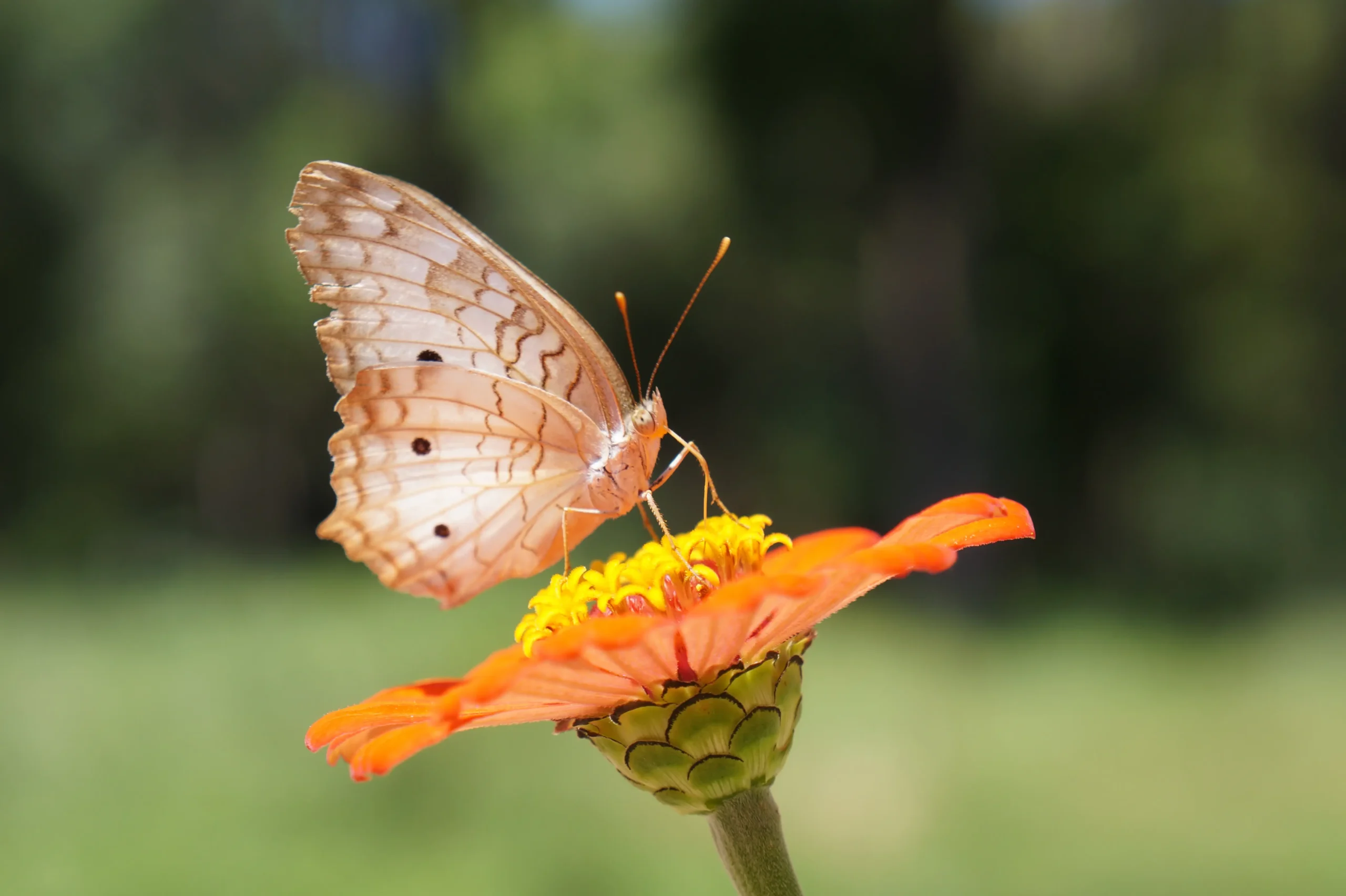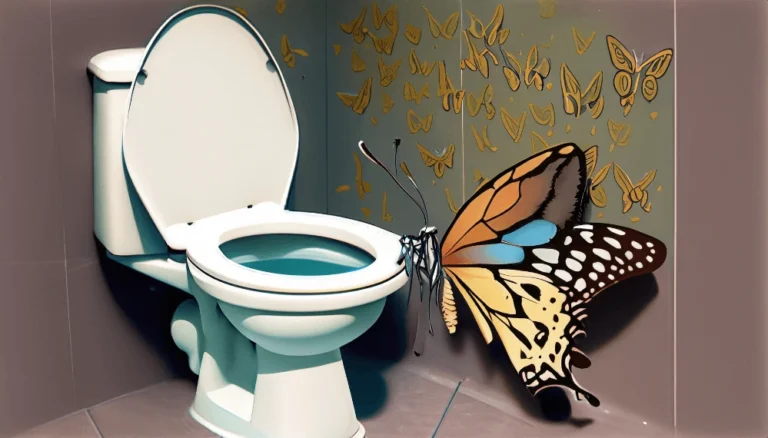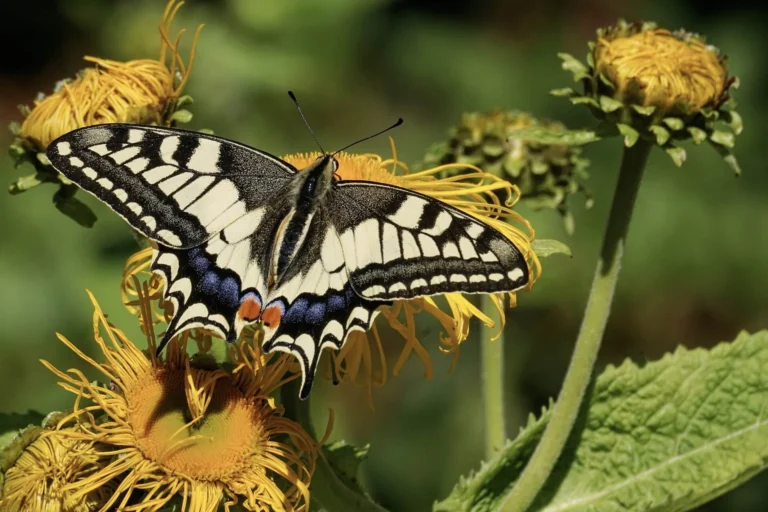The Ultimate Butterflies Guide: Identification, Conservation, Species & More
Butterflies, the fluttering gems of nature, have always held a special place in our hearts and ecosystems. These magnificent creatures are not only a symbol of beauty and transformation, but they play a crucial role in maintaining the balance of nature.
Welcome to our comprehensive guide where we journey into the captivating world of butterflies, unraveling the intricacies of butterfly identification and spotlighting the vital aspects of conservation.
In this ultimate butterfly guide, we will delve deep into the fascinating biology of these insects, helping you become proficient in butterfly identification, understanding their pivotal role in ecosystems, and fostering a profound appreciation for their beauty.
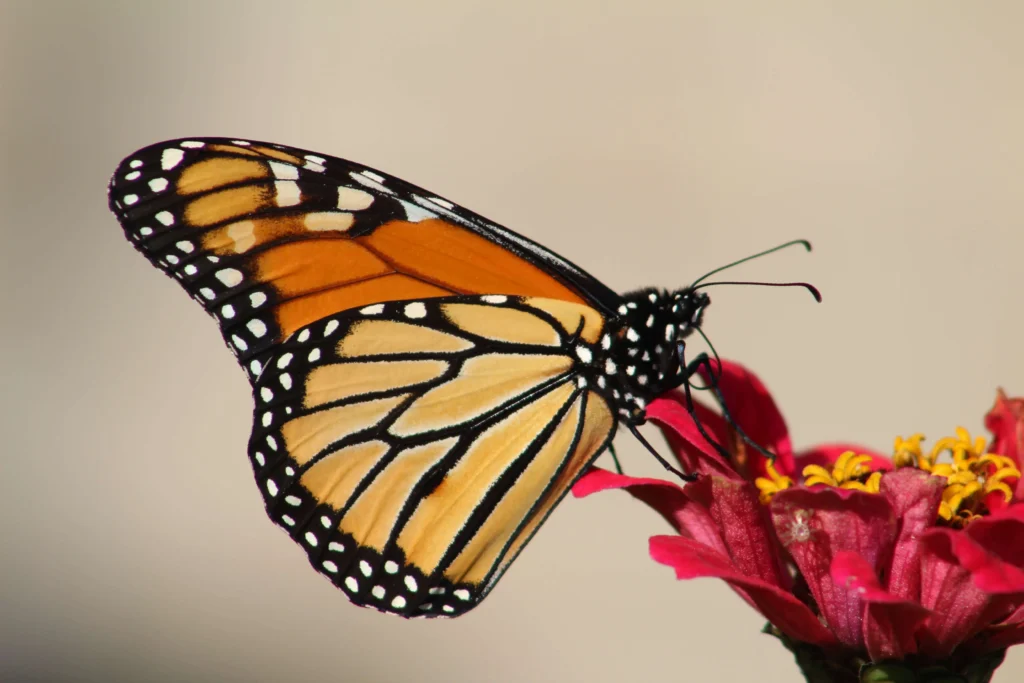
This guide is designed to be a rich resource for both enthusiasts and researchers, offering an in-depth look at their life cycles, anatomical structures, and the mesmerizing process of metamorphosis they undergo.
As we navigate through this guide, we will also venture into the delicate art of butterfly photography, providing you with invaluable tips to capture their beauty through your lens.
Additionally, this guide emphasizes the urgent need for butterfly conservation, highlighting the present status of various species and the community initiatives that are making a difference in safeguarding their habitats.
By immersing yourself in this guide, you will not only enhance your knowledge about these winged beauties but also understand your role in their conservation, fostering a harmonious coexistence with these magnificent creatures.
Table of Contents
Importance of Butterflies in the Ecosystem
Butterflies are not only beautiful, but they also do important jobs in nature. These delicate creatures help plants grow by spreading pollen from one flower to another, helping them to make seeds and fruits. These seeds and fruits are essential foods for many other animals.
Additionally, baby butterflies, known as larvae, are an important food for animals like birds and some insects. You can tell that a place is healthy and full of life when you see butterflies around, as they are signs of a happy and blooming environment.

Brief History of Butterfly Study
The study of butterflies, known as lepidopterology, has been around for a long time. People in ancient Egypt even drew pictures of butterflies on their walls around 3500 BC. During the Renaissance, many people began collecting butterflies and drawing detailed pictures of different types.
Nowadays, scientists are learning even more about butterflies, studying their genes, behavior, and how to protect them. This helps us understand more about these beautiful and fascinating creatures.
The Beauty and Allure of Butterflies
Butterflies have always caught people’s attention with their bright, colorful wings and gentle flight. They’ve inspired many forms of art, stories, and even fashion trends. In many cultures, butterflies are seen as symbols of hope and change, creating a deep bond between these delicate creatures and humans.
Their short-lived nature makes them even more special, reminding us to enjoy the beauty in the small moments and appreciate the wonders of nature that are embodied in these fluttering beauties.
Butterfly Biology

Anatomy
Wings
Butterfly wings are amazing creations of nature. They are made of very thin layers of a protein called chitin, which is found in the outer shell of other insects as well.
The wings are covered in small scales that give butterflies their bright colors and beautiful patterns. These wings not only help them fly but also control their body temperature and attract mates with their vibrant colors and patterns.
Body Structure
A butterfly’s body is sleek and divided into three main parts: the head, thorax, and abdomen. The head is where you find their complicated eyes and a special tube-shaped mouth for drinking nectar from flowers.
The thorax is like the butterfly’s engine room, holding the wings and legs, helping them fly and move around. The abdomen, on the other hand, has important organs for digesting food and making babies.
Sensory Organs
Butterflies have special organs to help them sense the world around them. Their eyes can see many colors, even some that humans can’t see, like ultraviolet.
Their antennae are like their noses, able to smell things from very far away, helping them find food and partners.
Lifecycle
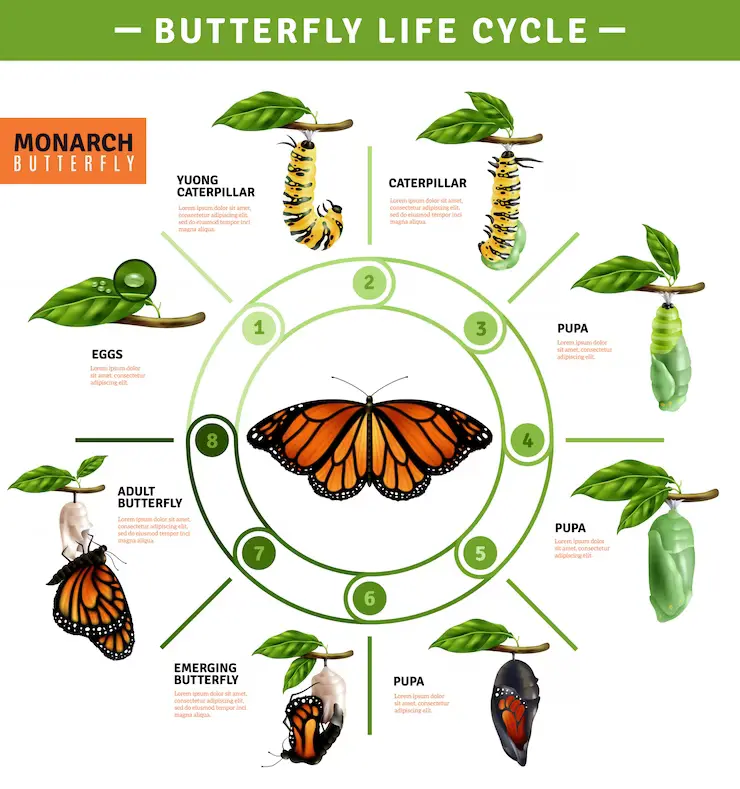
Egg
The butterfly’s journey starts as a tiny egg, usually laid on plant leaves which will be food for the baby butterfly, or caterpillar, when it hatches. These eggs are small but have a complex structure, holding the start of a new life.
Caterpillar
The egg opens up to reveal a caterpillar, which has a big appetite, eating lots of leaves to gather energy for the big change ahead. This stage is all about growing and getting ready for the next big step.
Pupa/Chrysalis
After being a caterpillar, it wraps itself in a case called a pupa or chrysalis. In this stage, it goes through a big change, turning its body into a new shape to become a butterfly.
Adult
When the change is complete, it comes out as a fully grown butterfly, ready to fly with its colorful wings. This is the last step of its amazing transformation, and now it starts looking for a partner to make new eggs and continue the cycle of life.
Metamorphosis
Stages of Metamorphosis
The life cycle of a butterfly, known as metamorphosis, is a special journey that includes different stages: egg, caterpillar, pupa, and adult. This transformation is a wonderful show of how creative nature can be, changing a caterpillar that crawls on the ground into a beautiful butterfly that can fly.
The Science Behind Metamorphosis
Understanding how metamorphosis works is a bit complex but really interesting. It’s controlled by special chemicals in the body and the butterfly’s genes. In this stage, the cells of the caterpillar change a lot, creating new parts and organs that help it turn into a butterfly.
This change is really an amazing display of the wonders of life on our planet.
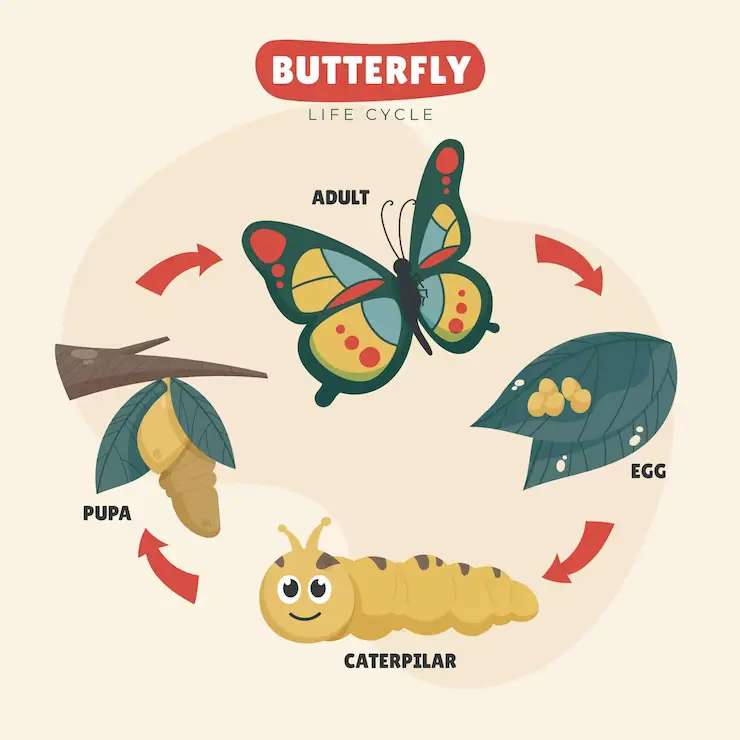
Significance in the Animal Kingdom
Metamorphosis is a one-of-a-kind process in the animal world, representing change and new beginnings. It helps butterflies to make use of different resources when they are young and when they are adults, which means they don’t have to compete as much for the same things, helping them to survive better.
Moreover, the way butterflies change shows how clever and adaptable life on Earth can be, making metamorphosis a fantastic example of evolution and the creativity of life.
Common Questions Regarding Butterfly Biology
What are the main body parts of a butterfly?
The butterfly mainly comprises the head, thorax, abdomen, wings, and antennae.
Why are butterfly wings so colorful?
The colors are due to microscopic scales on their wings which reflect light differently.
How long does it take for a butterfly to go from egg to adult?
It varies between species, generally ranging from a month to several months.
What do caterpillars eat?
Caterpillars primarily eat plant leaves, but their specific diet can vary between species.
What happens during the metamorphosis of a butterfly?
During metamorphosis, a caterpillar transforms into a butterfly, going through stages of egg, larva (caterpillar), pupa (chrysalis), and adult butterfly.
Why is metamorphosis significant in the animal kingdom?
It is a remarkable biological process showcasing complex transformation, adaptation, and survival strategies.
Identification & Classification
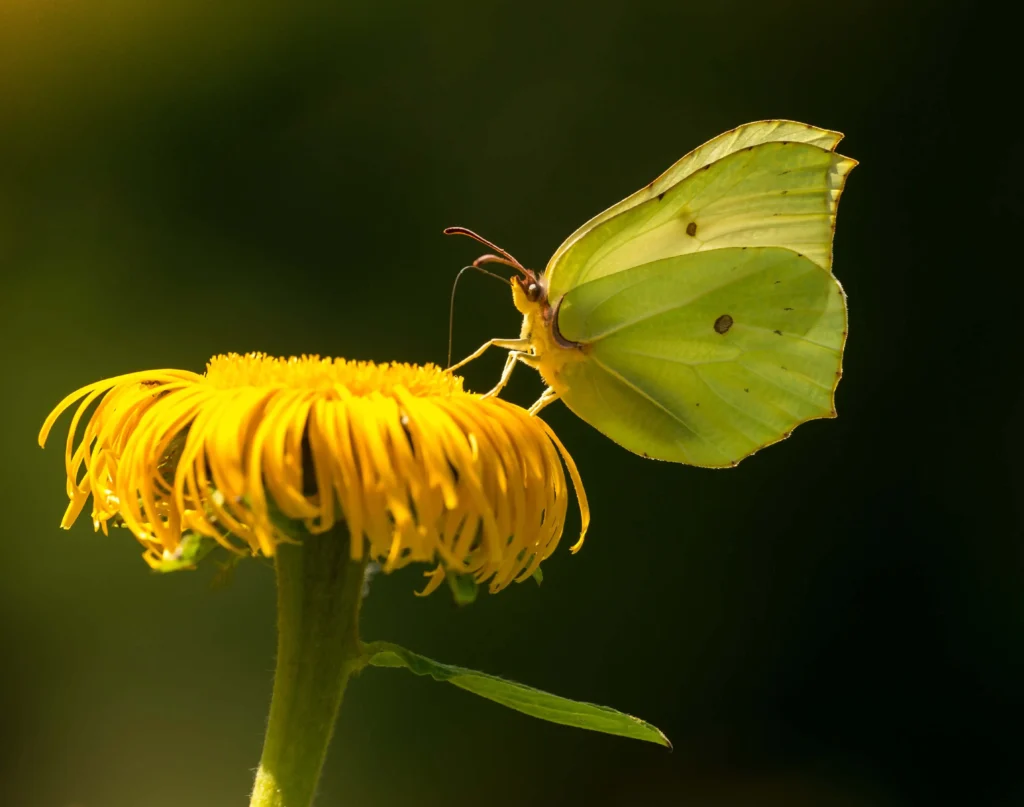
Getting to know the diverse world of butterflies starts with learning how to identify and group them into families. In this section, we’ll look at the different families butterflies belong to and the special features that make them different.
We’ll also talk about where in the world you can find different butterflies and give you some tips on how to recognize them by looking at the patterns, colors, and marks on their wings.
Butterfly Families
Papilionidae (Swallowtails)
Swallowtails are big, colorful butterflies that are part of the Papilionidae family. They have a “tail” on the back of their wings and are known for their bright colors and beautiful patterns, which makes them popular among people who love butterflies.
Pieridae (Whites and Sulphurs):
The butterflies from the Pieridae family, called Whites and Sulphurs, are smaller and usually have white, yellow, or green wings. You can often see them fluttering happily in gardens and fields.
Nymphalidae (Brush-footed Butterflies)
Brush-footed butterflies are a varied group from the Nymphalidae family. They have a lot of different colors and patterns and live in many different places, from forests to grasslands.
Lycaenidae (Gossamer-winged Butterflies)
The butterflies from the Lycaenidae family have very thin, almost see-through wings, which is why they are called Gossamer-winged butterflies. They are small but have many different colors and patterns.
Riodinidae (Metalmark Butterflies)
Metalmark butterflies are known for the metallic-looking marks on their wings. They are small to medium-sized butterflies.
Hesperiidae (Skippers)
Skippers are small butterflies with strong bodies. They fly quickly and in a way that’s different from other butterflies, and they hold their wings in a unique way too.
Geographic Distribution
Tropical Butterflies
In the tropical parts of the world, where it’s warm and rains a lot, you can find a wide variety of beautiful butterflies with vibrant colors and interesting adaptations.

Temperate Region Butterflies
In temperate regions, where the seasons change clearly, you can find butterflies with more subtle colors and patterns. These butterflies have found ways to live through the cold winter months.
Butterfly Biodiversity Hotspots
Some places in the world, like the Amazon Rainforest and Madagascar Island, are special because they are home to many unique butterfly species. These places are important for scientists studying butterflies and for efforts to protect butterflies and their homes.
Identification & Classification Guide
Wing Patterns
Looking at the patterns on a butterfly’s wings is a great way to identify different species. These patterns can be spots, stripes, and more. Recognizing these patterns can make watching butterflies even more enjoyable.
Colors and Markings
Butterflies are known for their bright and various colors and marks on their wings. These not only make them beautiful but also help them hide from predators, find mates, and send warnings to enemies. These colors come from special pigments and structures on their wings.
Size and Shape
Butterflies come in many different sizes and shapes. Knowing the differences in their sizes and shapes can help you identify and appreciate the vast diversity of butterflies.
FAQS Regarding Identification & Classification
What are the primary families of butterflies?
The primary butterfly families are Swallowtails, Whites and Sulphurs, Brush-footed Butterflies, Gossamer-wing Butterflies, Metalmarks, and Skippers.
How are butterflies classified into different families?
Butterflies are classified based on various characteristics like wing shape, color patterns, and feeding habits.
What are butterfly biodiversity hotspots?
These are regions with a high diversity of butterfly species, often rich in endemism, and usually have unique habitats that support specific butterfly communities.
Why is geographic distribution important in butterfly identification?
It helps in understanding the habitat preferences, migration patterns, and conservation status of different butterfly species.
How can you identify butterflies based on wing patterns?
Wing patterns, including the arrangement of colors and shapes, are key indicators in identifying different butterfly species.
What role do size and shape play in butterfly identification?
Size and shape often correlate with a butterfly’s family and species, aiding in proper identification and classification.
Habitats

Gardens & Parks
Creating a Butterfly Garden
Building a butterfly garden is a fun way to bring the beauty of butterflies right to your backyard. This involves choosing plants that give butterflies the nectar they need and places for their caterpillars to grow, making your garden a perfect spot for butterflies to live and flourish.
Plants that Attract Butterflies
Some plants are favorites for butterflies because they offer essential nectar and a good place to live. Planting flowers like milkweed, butterfly bush, and lavender can invite many different butterflies to your garden, adding lively colors and activities to your outdoor space.
Observing Butterflies in Parks
Parks are fantastic places to watch butterflies in their natural surroundings. Bring a guidebook and some binoculars to help you spend time enjoying the gentle flight of butterflies, identifying various species, and learning about their habits.
Forests
Butterflies of the Rainforests
Rainforests are bursting with different species of butterflies. These forests, full of green plants and various ecosystems, are the home to beautiful butterflies like the shining blue Morphos and the well-hidden Leaf butterflies.
Forest Conservation and Butterflies
Protecting forests is crucial in keeping the habitats of butterflies safe. By using good practices and restoring habitats, we can safeguard the many species of butterflies that live in forests for future generations to enjoy.
Species Native to Forest Environments
Forests house many butterfly species that have adapted to the unique conditions found there. Understanding the varieties found from the tree tops to the forest floor can make studying butterflies even more interesting.
Wetlands
Importance of Wetlands
Wetlands are important areas that support many kinds of plants and animals, including butterflies. These places, with water-rich soils and plenty of plants, offer a thriving environment for butterflies, showcasing a special side of butterfly ecology.
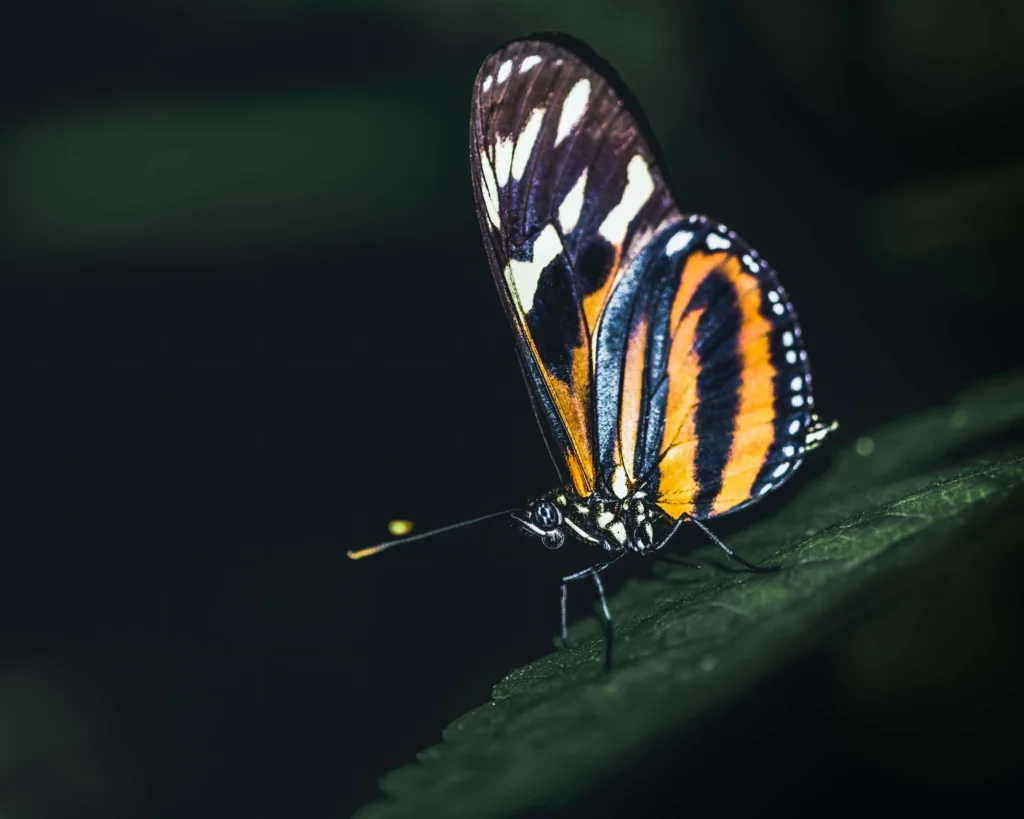
Wetland Butterflies and their Adaptations
Butterflies in wetlands have special habits and features that help them succeed in these areas. Learning about how these butterflies eat and reproduce can give us a glimpse into the amazing variety and adaptability of butterflies.
Conservation Efforts in Wetlands
Protecting wetlands is vital to preserve the homes of butterflies. Through actions like restoring habitats and creating protected areas, we can protect the special butterfly species that live in wetlands, helping global efforts to keep biodiversity alive and well.
Common Faqs Regarding Butterfly Habitats
How can you create a butterfly garden?
By planting native flowering plants, providing water sources, and creating sunning spots, you can attract and support various butterfly species.
What plants attract butterflies?
Plants like Milkweed, Butterfly Bush, and Lavender are known to attract butterflies due to their nectar-rich flowers.
Why are rainforests important for butterflies?
Rainforests provide diverse habitats with abundant food resources, making them a haven for a wide range of butterfly species.
How does forest conservation impact butterfly populations?
Forest conservation helps in preserving the natural habitats of butterflies, thereby supporting their survival and propagation.
What is the significance of wetlands for butterflies?
Wetlands offer unique ecosystems that support specific butterfly species, providing them with necessary resources and habitats.
How are wetland butterflies adapted to their environment?
Wetland butterflies have adaptations like specialized feeding habits and camouflaged colors to thrive in wetland environments.
Butterfly Species Profiles
In this section, we are taking a deeper look at the diverse and beautiful world of butterflies. We will explore some common species you might see fluttering around, as well as rare species that need our help to survive, and unique butterflies that stand out with their individual features or behaviors.
Common Butterfly Species
Discover some of the butterflies you might commonly see, helping both enthusiasts and beginners learn and identify these vibrant winged insects.
Monarch Butterfly (Danaus plexippus)
- Description: Renowned for their bright orange and black wings, monarchs are easily recognizable and famous worldwide.
- Habitat: Primarily spotted in North America, these butterflies undertake an immense migration journey every year.
- Conservation Status: Not Endangered.
- Unique Features or Behaviors: Famous for their mass migration, traveling thousands of miles from Canada to Central Mexico to avoid the cold winter.
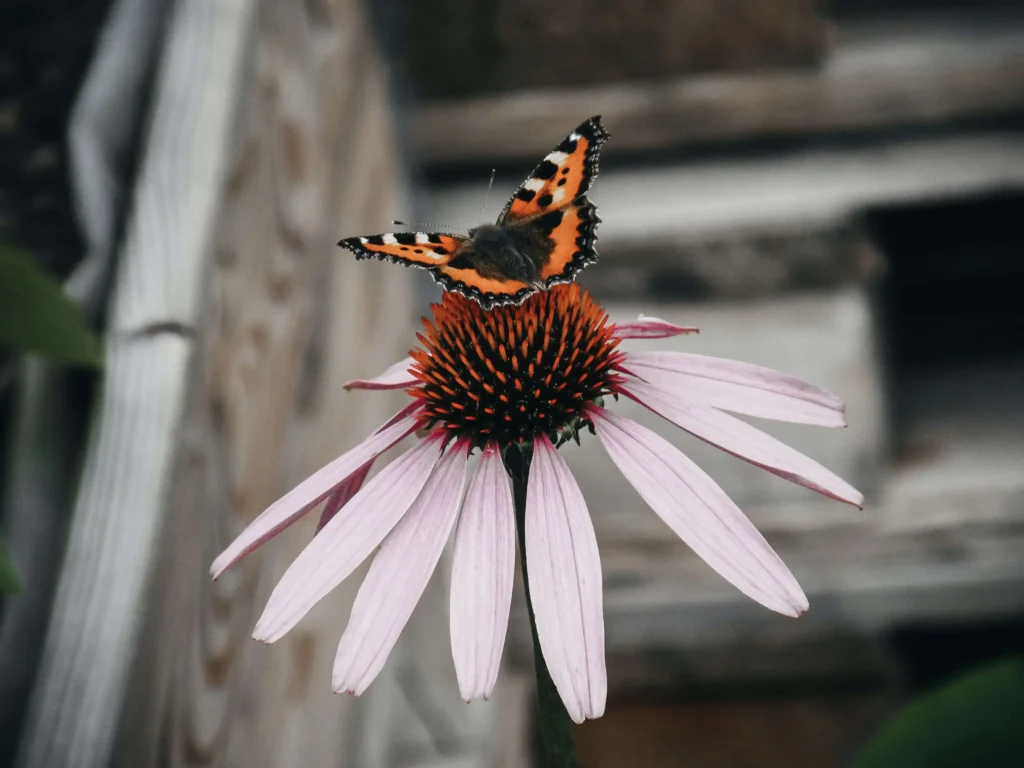
Swallowtail Butterfly (Papilio machaon)
- Description: A large and striking butterfly, identifiable by the tail-like extensions on its hind wings.
- Habitat: Found in diverse environments, from wetlands to gardens in North America and Asia.
- Conservation Status: Least Concern.
- Unique Features or Behaviors: Their colorful and varying patterns can change based on their geographic location.
Painted Lady Butterfly (Vanessa Cardui)
- Description: Medium-sized butterflies with a beautiful mix of orange, black, and white patterns on their wings.
- Habitat: Distributed globally except in South America, adapting well to various environments.
- Conservation Status: Least Concern.
- Unique Features or Behaviors: Known for migrating in large groups across great distances.
Rare and Endangered Butterfly Species
We spotlight the butterflies that are rare and endangered, emphasizing the urgent need for efforts to protect them.
Queen Alexandra’s Birdwing (Ornithoptera alexandrae)
- Description: The world’s largest butterfly is captivating with its vibrant and intricate wing patterns.
- Habitat: Exclusively found in the rainforests of Papua New Guinea.
- Conservation Status: Critically Endangered.
- Unique Features or Behaviors: Their massive size and bright colors make them a spectacular sight in their natural habitat.
Miami Blue (Cyclargus thomasi bethunebakeri)
- Description: A small butterfly, sporting a dazzling blue color on the upper sides of its wings.
- Habitat: Once common in Florida, it is now mostly found in select coastal areas in southern Florida.
- Conservation Status: Endangered.
- Unique Features or Behaviors: Their numbers have drastically fallen due to habitat loss, underscoring the importance of conservation.
Unique Butterfly Species
Highlighting butterflies that are known for their distinct features or behaviors, giving a peek into the fascinating world of butterflies.
Blue Morpho (Morpho peleides)
- Description: Famous for their bright blue iridescent wings, they are one of the largest butterflies globally.
- Habitat: Inhabit the tropical forests of Latin America, ranging from Mexico to Colombia.
- Conservation Status: Not Endangered.
- Unique Features or Behaviors: The blue hue of their wings is a result of microscopic scales that reflect light, not pigmentation.
Glasswing Butterfly (Greta oto)
- Description: Recognizable by its transparent wings, allowing a unique camouflage strategy against predators.
- Habitat: Mostly found in the rainforests of Central and South America.
- Conservation Status: Not Assessed.
- Unique Features or Behaviors: The wings lack pigmentation, which gives them a transparent appearance, offering a unique form of camouflage.
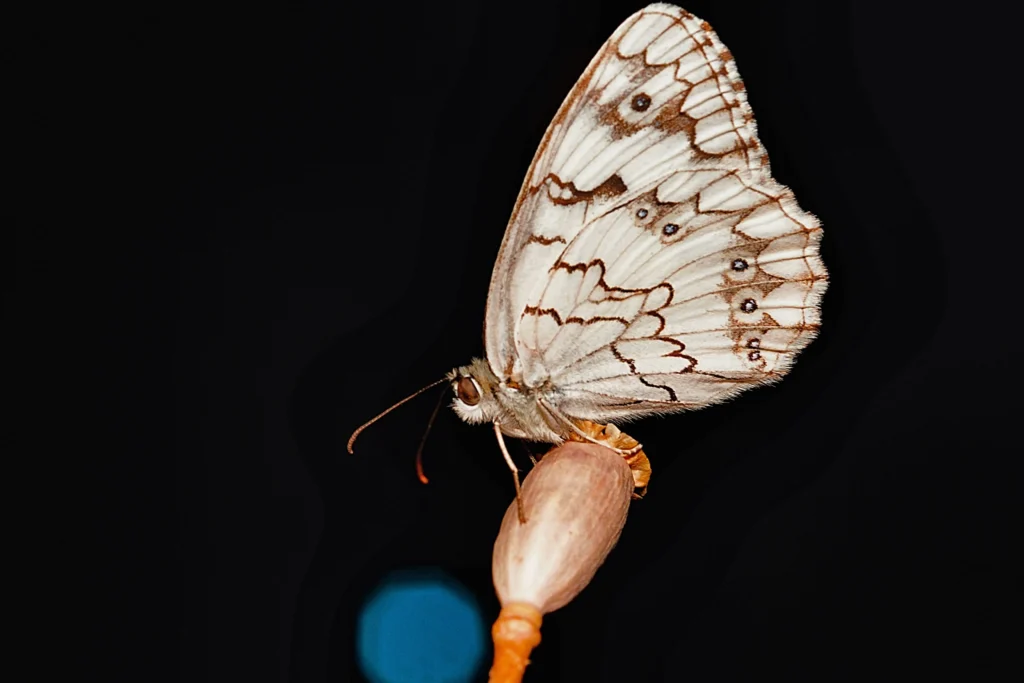
Conservation
Endangered Species
Current Status of Butterfly Populations
In recent decades, there has been a troubling decline in butterfly populations. This decrease varies between species, with some facing more severe challenges.
The main contributors to this decline include habitat loss, climate change, and pesticide usage. Global efforts are underway to monitor and conserve butterfly populations.
Threats Faced
In today’s changing environment, butterflies encounter numerous threats. Urbanization and agriculture expansion have led to habitat destruction, a primary challenge.
Climate change has altered species distribution and food resource availability. Moreover, pesticides and pollutants pose direct threats, contaminating food sources and causing direct harm.
Profiles of Endangered Species
Many butterfly species are at risk of extinction today. Some critical ones are:
- The Monarch Butterfly: At risk due to the diminishing milkweed plants, their primary food source.
- The Miami Blue Butterfly: Critically endangered due to habitat fragmentation and loss.
- The Western Swallowtail Butterfly: Endangered because of pesticide use affecting their survival rate.
Efforts to conserve these and other species include habitat restoration and protection from poaching.
Habitat Restoration
Reforestation
Planting native trees and shrubs, is vital for creating natural habitats for butterflies, and supplying food and breeding grounds. Moreover, forests help balance the ecosystem by absorbing carbon dioxide, mitigating climate change impacts.
4.2.2 Wetland Restoration
Replenishing water sources and reintroducing native plants is essential for restoring wetlands, and providing food and shelter for butterflies. This not only aids butterflies but also improves ecosystem health, benefiting other wildlife species and enhancing water quality.
4.2.3 Creating Butterfly Habitats at Home
Individual efforts can also make a significant difference. Planting butterfly-friendly plants, avoiding pesticides, and providing shelter can invite butterflies to your garden. Establishing a butterfly garden with plants like milkweed and lavender can create a sanctuary for butterflies in your backyard.
I hope this detailed profile helps in understanding the enchanting world of butterflies more deeply. Let me know if you would like any further information or specific details.
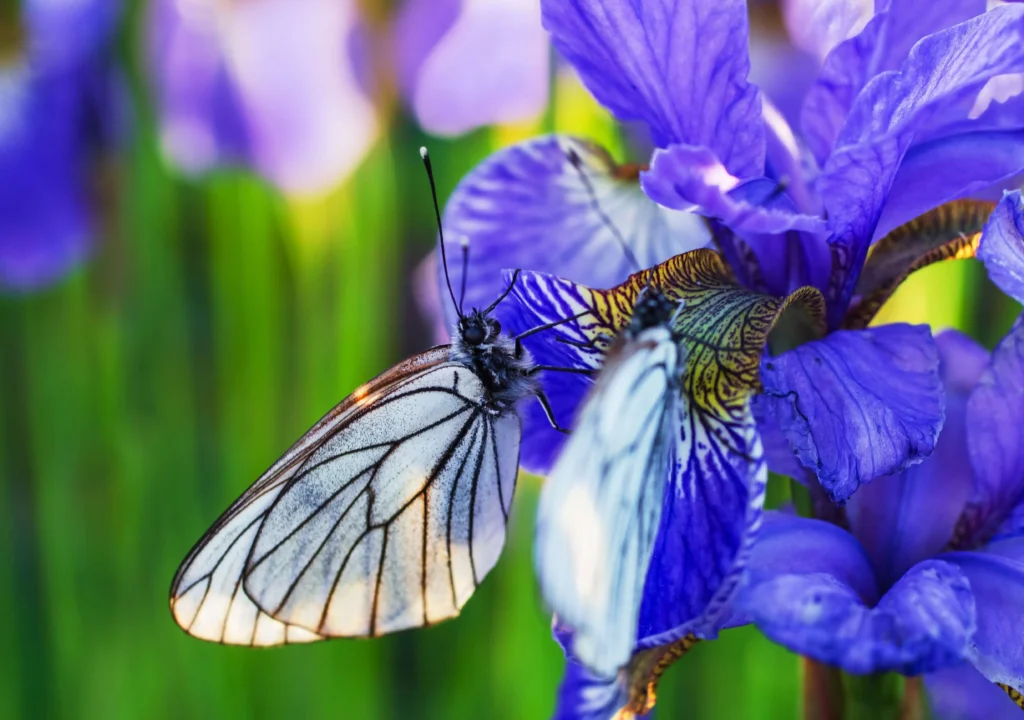
Community Initiatives
Volunteer Programs
Many volunteer groups are helping to protect butterflies. They invite people to help watch over butterfly numbers, fix up their homes, and teach others about them. When you volunteer, you can really help keep butterflies safe.
Community Butterfly Gardens
Local butterfly gardens are group projects that make welcoming places for butterflies. These gardens are homes for butterflies and places where people can learn why it’s important to protect them. They’re great spots for learning and talking about butterflies and how to keep them safe.
Learning and Spreading the Word
Learning and spreading the word are very important for saving butterflies. Programs that teach people why butterflies are important and the dangers they face can help a lot.
Holding workshops, talks, and events in the community are great ways to get the word out and get people involved in helping butterflies.
Faqs About Butterfly Conservations
What defines a butterfly species as endangered?
A type of butterfly is seen as endangered when it’s very likely to disappear from the wild, mainly because of losing homes, changing weather, or what people are doing.
What are the common threats faced by butterfly populations?
Butterflies often deal with losing homes, pollution, new species taking over, and changes in the weather.
How does reforestation help in conserving butterfly species?
Planting trees helps make and fix homes where butterflies can live happily. It makes sure they have food and places to have their babies.
Can individuals participate in habitat restoration?
Yes, anyone can help by joining local projects, planting local plants, and supporting groups that protect butterflies.
What role do community butterfly gardens play in conservation?
These gardens give butterflies safe places to live, help increase their numbers, and are places where people can learn about saving butterflies.
How can one get involved in butterfly conservation initiatives?
You can join by helping out in local groups, counting butterflies, and supporting groups that protect butterflies.
Butterfly Watching and Photography
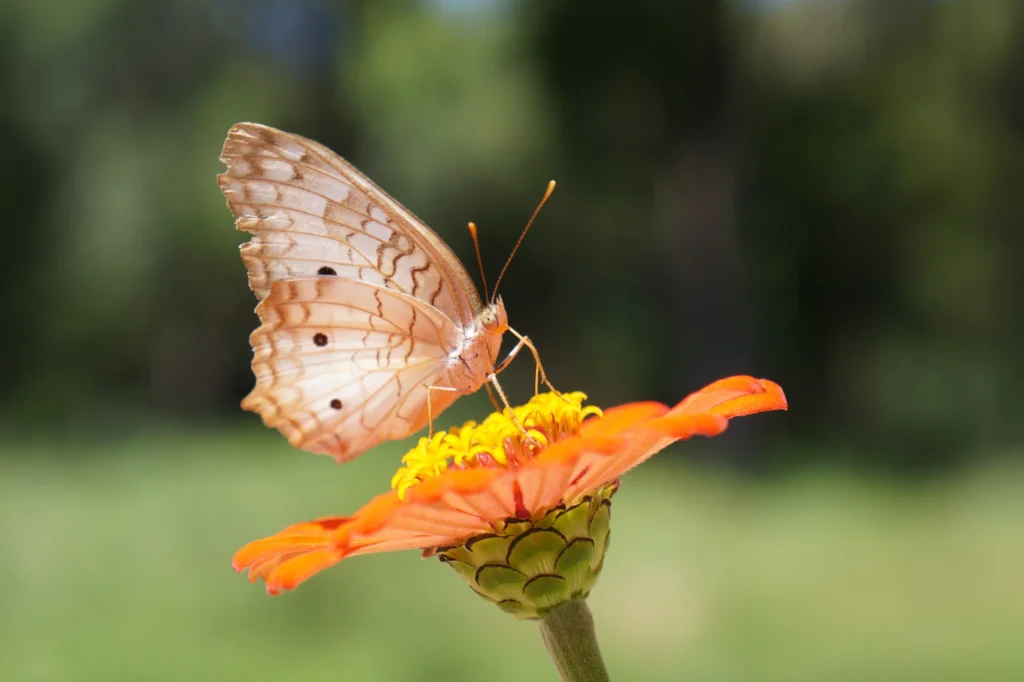
Tips for Butterfly Watching
Best Time and Places
Watching butterflies is a calm and satisfying thing to do. The best times are warm, sunny days, usually from late morning to early afternoon when they’re very active.
The best places to watch them are gardens, parks, and areas with lots of flowers. Different places have special kinds of butterflies, so find out about the butterfly spots near you to have a great time watching them.
5.1.2 Tools and Equipment
For the best butterfly-watching, bring binoculars to see them up close, a notebook to write down what you see, and a guidebook to know different kinds.
Wear clothes that don’t scare the butterflies away and bring a hat and sunscreen to protect yourself from the sun.
Respectful Observation
When watching butterflies, stay far enough away so you don’t bother them. Don’t touch or catch them because it can hurt them. Enjoy their beauty from afar and use your binoculars for a close-up view.
Butterfly Photography
Tips for Capturing Stunning Photos
Taking photos of butterflies is an art that takes time and practice. Here are some tips for great photos:
- Lighting: Use the morning or late afternoon light to make your photos beautiful.
- Background: Choose a simple background that lets the butterfly stand out.
- Focus: Make sure the butterfly’s eyes are in focus to get a clear picture.
- Patience: Move slowly and wait for the right moment to get the perfect shot.
Photography Equipment
For butterfly photos, use a camera that lets you take close-up shots without scaring the butterfly. A tripod keeps your camera steady for clear pictures. A wide-angle lens is also good for showing butterflies in their natural place.
Sharing and Showcasing Your Photos
Share your beautiful butterfly pictures with others. You can start a blog about your experiences, join groups online to share your pictures, or even show your photos at exhibitions.
Sharing pictures can make others love butterflies too and maybe they’ll want to help protect them as well.
Common Questions About Butterfly Watching & Photography
What is the best time for butterfly-watching?
The warm months are the best, especially in the morning to midday.
What equipment is recommended for butterfly watching?
Bring binoculars, a guidebook for knowing the kinds, and a notebook for notes..
What tips do you have for capturing stunning butterfly photos?
For capturing beautiful butterfly photos, use a macro lens, maintain a steady hand, and use natural light to highlight the colors and patterns of the butterflies.
How can you showcase your butterfly photographs?
You can showcase your butterfly photographs through social media platforms, photo exhibitions, and personal blogs or websites.
Conclusion
The Importance of Butterflies
Butterflies aren’t just beautiful creatures that add beauty and grace to our environments; they play significant roles in the ecosystem. They act as pollinators for a variety of plants, aiding in the production of fruits and vegetables that we consume daily.
Moreover, their presence in an area often indicates a healthy and balanced ecosystem, as they are quite sensitive to changes in the environment.
Their migratory patterns and life cycles also offer invaluable insights into the workings of the biological and environmental spheres.
By observing them, we can learn more about different habitats and the intricate connections between various species. In essence, they help us unravel the complex web of life on Earth.
Your Role in Butterfly Conservation
You might wonder how a single person can contribute to the conservation of butterflies. Well, every little effort counts! Even simple acts can have a big impact. You can start by setting up a butterfly-friendly space in your garden, planting native flowers and plants that provide nourishment for butterflies.
Spreading the word about the importance of butterflies and the threats they face is another significant step. Educating those around you can create a ripple effect, leading to more community involvement and possibly influencing policy changes at a higher level.
Participating in local butterfly conservation programs, volunteering for habitat restoration, and donating to organizations focused on butterfly conservation are other ways you can make a considerable difference.
By dedicating your time and resources, you are not only helping to preserve butterfly populations but also contributing to maintaining a vibrant and healthy ecosystem for future generations.
Remember, butterflies are an integral part of our planet’s biodiversity. Their conservation ensures the stability and richness of our environments. Thus, by protecting them, we are in essence safeguarding our own futures and promoting a richer, more biodiverse planet for generations to come.
Additional Resources
Butterfly Books I Recommend
- “The Butterfly Garden: Turning Your Garden, Window Box, or Backyard into a Beautiful Home for Butterflies” by Mathew Tekulsky
- “Butterflies of North America” by Jim P. Brock and Kenn Kaufman
Butterfly Checklists (by Region)
North America:
- Monarch (Danaus plexippus)
- Habitat: Meadows, roadsides, gardens
- Season: Spring to fall
- Eastern Tiger Swallowtail (Papilio glaucus)
- Habitat: Forest edges, riversides, meadows
- Season: Spring to early fall
- Painted Lady (Vanessa Cardui)
- Habitat: Gardens, meadows, roadside areas
- Season: Spring to fall
- Red Admiral (Vanessa Atalanta)
- Habitat: Gardens, woodlands, marshes
- Season: Spring to fall
- American Lady (Vanessa virginiensis)
- Habitat: Open areas, gardens, meadows
- Season: Spring to fall
Europe:
- Peacock Butterfly (Aglais io)
- Habitat: Gardens, woodlands, meadows
- Season: Spring to autumn
- Common Blue (Polyommatus icarus)
- Habitat: Grasslands, meadows, wastelands
- Season: Late spring to early autumn
- Brimstone (Gonepteryx rhamni)
- Habitat: Woodlands, meadows, hedgerows
- Season: Spring to autumn
- Swallowtail (Papilio machaon)
- Habitat: Meadows, marshlands
- Season: Spring to early autumn
- Silver-washed Fritillary (Argynnis Paphia)
- Habitat: Woodlands, forests
- Season: Summer
Asia:
- Asian Swallowtail (Papilio xuthus)
- Habitat: Gardens, woodlands, urban areas
- Season: Year-round in subtropical regions
- Common Jezebel (Delias eucharis)
- Habitat: Forests, gardens, urban areas
- Season: Year-round
- Blue Glassy Tiger (Ideopsis vulgaris)
- Habitat: Forests, grasslands, coastal mangroves
- Season: Year-round in tropical regions
- Clipper (Parthenos Sylvia)
- Habitat: Forested areas, gardens
- Season: Year-round in tropical regions
- Great Mormon (Papilio Memnon)
- Habitat: Forests, gardens, hill areas
- Season: Year-round in tropical regions
Recommended Websites
If you’re curious to learn more about butterflies and how to help them, here are a couple of websites that are packed with great information and ways to get involved in helping butterflies:
This UK-based group is all about saving butterflies, moths, and the places they live in the UK. It’s a great spot to visit whether you’re just starting to learn about butterflies or you’re already a big fan.
You’ll find lots of research, guides, and the latest news on how to help butterflies around the world. So, if you want to learn more or even get involved in helping out, this site has loads of info to help you get started.
North American Butterfly Association (NABA)
This non-profit group in North America is focused on helping people enjoy butterflies and protect them at the same time. It’s perfect for anyone, from people who just like watching butterflies to those who are really serious about helping them.
The website offers tips on making butterfly-friendly gardens, gives you detailed information on the different types of butterflies found in North America, and shows you how to get actively involved in saving butterflies. If you’re based in North America, this is a wonderful place to connect with other people who care about butterflies just like you.
I suggest visiting these websites not just to find out more but also to join forces with groups of people who are working hard to look after butterflies.
You can use these sites to build up your knowledge, help out with butterfly protection efforts, and join a worldwide group of people focused on keeping butterflies and the places they live safe and sound.


